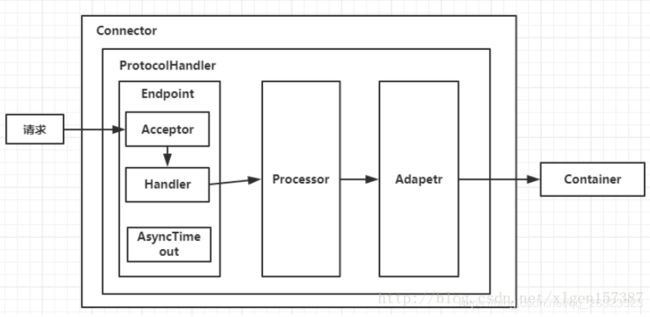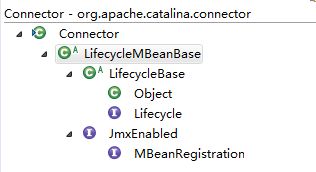Tomcat源码解析:Web请求处理过程
前言:
Catalina是Tomcat提供的Servlet容器实现,它负责处理来自客户端的请求并处理响应。
但是仅有Servlet容器服务器是无法对外提供服务的,还需要由连接器接收来自客户端的请求,并按照既定协议进行解析,然后交由Servlet容器处理
1.Coyote
Coyote是Tomcat连接器框架的名称。客户端通过Coyote与服务器建立连接、发送请求并接收响应
Coyote封装了底层的网络通信,为Catalina容器提供了统一的接口,使Catalina与具体的请求协议及IO方式解耦。
1)Coyote支持的传输协议
* HTTP/1.1 主要用于Tomcat单独运行的情况
* AJP 用于和web服务器(Apache HTTP Server)集成,以实现针对静态资源的优化以及集群部署
* HTTP/2.0 下一代HTTP协议,自Tomcat8.5以及9.0版本开始支持
2)Coyote按照IO方式不同提供不同的方法
* NIO
* NIO2
* APR(Apache Portable Runtime)
2.Coyote框架主要实现类
先复用一张别人的图来说明请求的处理过程,所涉及的节点(来自https://blog.csdn.net/xlgen157387/article/details/79006434 )
这里先直接写实现步骤,下面会用源码分析的方式来确定其过程
1)Endpoint 具体的Socket接收处理类,是对传输层的抽象。
2)Processor 负责构造Request和Response对象,是对应用层的抽象
3)Adapter 将请求适配到Servlet容器进行具体的处理
从以上的图可以直观的看一下一个请求真正到具体的Container要经过的步骤,下面就从源码角度来分析一下这张图
3.Connector的结构分析
1)Connection的结构
Connection主要源码如下:
public class Connector extends LifecycleMBeanBase {
protected Service service = null;
// 默认的ProtocolHandler实现
protected String protocolHandlerClassName = "org.apache.coyote.http11.Http11NioProtocol";
protected final ProtocolHandler protocolHandler;
protected Adapter adapter = null;
@Override
protected void startInternal() throws LifecycleException {
// Validate settings before starting
if (getPort() < 0) {
throw new LifecycleException(sm.getString(
"coyoteConnector.invalidPort", Integer.valueOf(getPort())));
}
setState(LifecycleState.STARTING);
try {
// 启动protocolHandler
protocolHandler.start();
} catch (Exception e) {
String errPrefix = "";
if(this.service != null) {
errPrefix += "service.getName(): \"" + this.service.getName() + "\"; ";
}
throw new LifecycleException
(errPrefix + " " + sm.getString
("coyoteConnector.protocolHandlerStartFailed"), e);
}
}
}由上可知,ProtocolHandler的默认实现为Http11NioProtocol
2)Connector被创建的时机
在Catalina解析server.xml时,也就是在Catalina.createStartDigester()方法中,有以下代码
digester.addRule("Server/Service/Connector",
new ConnectorCreateRule());
digester.addRule("Server/Service/Connector",
new SetAllPropertiesRule(new String[]{"executor", "sslImplementationName"}));
digester.addSetNext("Server/Service/Connector",
"addConnector",
"org.apache.catalina.connector.Connector");
可以看到,Connector就是再Catalina解析的server.xml的时候创建的
3)Connection.start()启动Connection包含的一系列组件
Connection在Catalina解析server.xml时候被创建,那么Connection以及Connection包含的组件是什么时候被启动的呢?
我们知道Connection属于Service,Service属于Server,Server在解析后创建启动,同时也通过调用其start()方法启动了Service、Connection
由1)可知,Connection.start()调用了ProtocolHandler.start()方法,下面我们来看下这个start方法
4.Http11NioProtocol源码分析
类结构如上图所示
1)主要成员变量分析
存在AbstractProtocol类中,如下所示:
public abstract class AbstractProtocol implements ProtocolHandler,
MBeanRegistration {
/**
* Endpoint that provides low-level network I/O - must be matched to the
* ProtocolHandler implementation (ProtocolHandler using NIO, requires NIO
* Endpoint etc.).
*/
private final AbstractEndpoint endpoint;
/**
* The adapter provides the link between the ProtocolHandler and the
* connector.
*/
protected Adapter adapter;
private final Set waitingProcessors =
Collections.newSetFromMap(new ConcurrentHashMap());
/**
* Create and configure a new Processor instance for the current protocol
* implementation.
*
* @return A fully configured Processor instance that is ready to use
*/
protected abstract Processor createProcessor(); 通过源码,我们更验证了上图的正确性
ProtocolHandler包含了Endpoint、Processor、Adapter,三个类各司其职,共同完成请求的解析、封装、传递
2)ProtocolHandler.start()启动方法
下面我们来看下Handler启动时完成哪些动作
// 具体实现在AbstractProtocol.start()方法中
@Override
public void start() throws Exception {
if (getLog().isInfoEnabled())
getLog().info(sm.getString("abstractProtocolHandler.start",
getName()));
try {
// 主要就是启动endpoint
endpoint.start();
} catch (Exception ex) {
getLog().error(sm.getString("abstractProtocolHandler.startError",
getName()), ex);
throw ex;
}
...
}由上可知:ProtocolHandler启动时主要完成的就是endpoint的启动
5.Endpoint.start()
Tomcat中没有Endpoint,默认使用的是AbstractEndpoint
// AbstractEndpoint.start()
public final void start() throws Exception {
if (bindState == BindState.UNBOUND) {
// bind方法主要就是创建ServerSocket,关联到用户指定的地址
bind();
bindState = BindState.BOUND_ON_START;
}
// startInternal是一个抽象方法,默认实现在其子类中
startInternal();
}我们当前使用的AbstractEndpoint实现类是NioEndpoint,其startInternal方法如下:
/**
* Start the NIO endpoint, creating acceptor, poller threads.
*/
@Override
public void startInternal() throws Exception {
if (!running) {
running = true;
paused = false;
processorCache = new SynchronizedStack<>(SynchronizedStack.DEFAULT_SIZE,
socketProperties.getProcessorCache());
eventCache = new SynchronizedStack<>(SynchronizedStack.DEFAULT_SIZE,
socketProperties.getEventCache());
nioChannels = new SynchronizedStack<>(SynchronizedStack.DEFAULT_SIZE,
socketProperties.getBufferPool());
// 1.创建Executor
if ( getExecutor() == null ) {
createExecutor();
}
// 2.创建最大连接数限制类
initializeConnectionLatch();
// 3.创建Poller,并启动线程执行Poller任务
pollers = new Poller[getPollerThreadCount()];
for (int i=0; i下面我们逐个来分析上面四个方法
1)createExecutor()主要就是创建一个线程池
// AbstractEndpoint.createExecutor()
public void createExecutor() {
internalExecutor = true;
TaskQueue taskqueue = new TaskQueue();
TaskThreadFactory tf = new TaskThreadFactory(getName() + "-exec-", daemon, getThreadPriority());
executor = new ThreadPoolExecutor(getMinSpareThreads(), getMaxThreads(), 60, TimeUnit.SECONDS,taskqueue, tf);
taskqueue.setParent( (ThreadPoolExecutor) executor);
}2)initializeConnectionLatch()创建最大连接数限制类
// AbstractEndpoint.initializeConnectionLatch()
protected LimitLatch initializeConnectionLatch() {
if (maxConnections==-1) return null;
if (connectionLimitLatch==null) {
// 主要就是创建LimitLatch
// 通过查看LimitLatch的源码可知,其就是一个最大连接数的限制类
connectionLimitLatch = new LimitLatch(getMaxConnections());
}
return connectionLimitLatch;
}3)Poller
4)startAcceptorThreads()同Poller一样,创建一定数量的Acceptor,并创建线程启动Acceptor任务
// AbstractEndpoint.startAcceptorThreads()
protected final void startAcceptorThreads() {
int count = getAcceptorThreadCount();
acceptors = new Acceptor[count];
for (int i = 0; i < count; i++) {
acceptors[i] = createAcceptor();
String threadName = getName() + "-Acceptor-" + i;
acceptors[i].setThreadName(threadName);
Thread t = new Thread(acceptors[i], threadName);
t.setPriority(getAcceptorThreadPriority());
t.setDaemon(getDaemon());
t.start();
}
}有关于Poller和Acceptor我们单独分析
我们先来看Acceptor
6.NioEndpoint.Acceptor(接收客户端连接,并注册)
Acceptor源码如下
是一个抽象类,实现Runnable接口,没有实现run方法,具体在子类中实现
public abstract static class Acceptor implements Runnable {
public enum AcceptorState {
NEW, RUNNING, PAUSED, ENDED
}
protected volatile AcceptorState state = AcceptorState.NEW;
public final AcceptorState getState() {
return state;
}
private String threadName;
protected final void setThreadName(final String threadName) {
this.threadName = threadName;
}
protected final String getThreadName() {
return threadName;
}
}Acceptor有三个具体实现类,我们来看下NioEndpoint.Acceptor
protected class Acceptor extends AbstractEndpoint.Acceptor {
@Override
public void run() {
...
while (running) {
try {
//1.判断是否超过最大连接数,超过则等待
countUpOrAwaitConnection();
SocketChannel socket = null;
try {
// 2.传统的获取客户端socket连接方式
socket = serverSock.accept();
} catch (IOException ioe) {
...
}
...
// Configure the socket
if (running && !paused) {
// 3.将socket封装,重点就在这个方法里
if (!setSocketOptions(socket)) {
closeSocket(socket);
}
...
}
...
}
// NioEndpoint.setSocketOptions()
protected boolean setSocketOptions(SocketChannel socket) {
// Process the connection
try {
socket.configureBlocking(false);
// 1.获取socket
Socket sock = socket.socket();
socketProperties.setProperties(sock);
// 2.NioChannel本质上是 SocketChannel,
NioChannel channel = nioChannels.pop();
if (channel == null) {
SocketBufferHandler bufhandler = new SocketBufferHandler(
socketProperties.getAppReadBufSize(),
socketProperties.getAppWriteBufSize(),
socketProperties.getDirectBuffer());
if (isSSLEnabled()) {
channel = new SecureNioChannel(socket, bufhandler, selectorPool, this);
} else {
channel = new NioChannel(socket, bufhandler);
}
} else {
channel.setIOChannel(socket);
channel.reset();
}
// 3.注册到Poller,关键的一步
// getPoller0()方法轮询的办法从Poller[]数组中获取一个Poller,并将NioChannel注册其中
getPoller0().register(channel);
} catch (Throwable t) {
ExceptionUtils.handleThrowable(t);
try {
log.error("",t);
} catch (Throwable tt) {
ExceptionUtils.handleThrowable(tt);
}
// Tell to close the socket
return false;
}
return true;
}
// Poller.register(channel)
// NioEndpoint.Poller.register(channel)
public void register(final NioChannel socket) {
socket.setPoller(this);
NioSocketWrapper ka = new NioSocketWrapper(socket, NioEndpoint.this);
socket.setSocketWrapper(ka);
ka.setPoller(this);
ka.setReadTimeout(getSocketProperties().getSoTimeout());
ka.setWriteTimeout(getSocketProperties().getSoTimeout());
ka.setKeepAliveLeft(NioEndpoint.this.getMaxKeepAliveRequests());
ka.setSecure(isSSLEnabled());
ka.setReadTimeout(getSoTimeout());
ka.setWriteTimeout(getSoTimeout());
// 1.获取一个PollerEvent
PollerEvent r = eventCache.pop();
// 2.对NioSocketWrapper注册读事件
ka.interestOps(SelectionKey.OP_READ);
// 3.将socket绑定到PollerEvent事件中
if ( r==null) r = new PollerEvent(socket,ka,OP_REGISTER);
else r.reset(socket,ka,OP_REGISTER);
// 4.将绑定后的事件添加到Poller的events中
addEvent(r);
}到这里,我们先总结一下Acceptor所做的工作:
1)作为一个独立线程,在run方法中无限轮询,检查客户端连接
2)一旦有客户端连接进来,则将对应socket封装为NioChannel
3)将NioChannel绑定到一个PollerEvent事件中
4)将对应的PollerEvent方法Poller的events中,等待执行
7.NioEndpoint.PollerEvent
上面说到将NioChannel绑定到一个PollerEvent中,并将PollerEvent放入events中,我们先来看到PollerEvent
public static class PollerEvent implements Runnable {
private NioChannel socket;
private int interestOps;
private NioSocketWrapper socketWrapper;
...
@Override
public void run() {
// 1.如果是注册事件,则将对应的SocketChannel注册到Selector上,并监听READ事件
// 可以对照刚才的Poller.register(NioChannel)方法,注册的就是OP_REGISTER事件
// 并将socketWrapper作为attachment
if (interestOps == OP_REGISTER) {
try {
socket.getIOChannel().register(
socket.getPoller().getSelector(), SelectionKey.OP_READ, socketWrapper);
} catch (Exception x) {
log.error(sm.getString("endpoint.nio.registerFail"), x);
}
} else {
final SelectionKey key = socket.getIOChannel().keyFor(socket.getPoller().getSelector());
try {
if (key == null) {
// The key was cancelled (e.g. due to socket closure)
// and removed from the selector while it was being
// processed. Count down the connections at this point
// since it won't have been counted down when the socket
// closed.
socket.socketWrapper.getEndpoint().countDownConnection();
} else {
// 2.TODO
final NioSocketWrapper socketWrapper = (NioSocketWrapper) key.attachment();
if (socketWrapper != null) {
//we are registering the key to start with, reset the fairness counter.
int ops = key.interestOps() | interestOps;
socketWrapper.interestOps(ops);
key.interestOps(ops);
} else {
socket.getPoller().cancelledKey(key);
}
}
} catch (CancelledKeyException ckx) {
try {
socket.getPoller().cancelledKey(key);
} catch (Exception ignore) {}
}
}
}
}总结:主要是给所有的客户端连接监听READ事件
8.NioEndpoint.Poller(关键节点,监听客户端事件,并将事件传递给Process处理)
public class Poller implements Runnable {
private Selector selector;
private final SynchronizedQueue events =
new SynchronizedQueue<>();
// 获取所有的事件,并逐个执行
public boolean events() {
boolean result = false;
PollerEvent pe = null;
while ( (pe = events.poll()) != null ) {
result = true;
try {
// 处理完成之后,清空event事件,供下一次注册使用
pe.run();
pe.reset();
if (running && !paused) {
eventCache.push(pe);
}
} catch ( Throwable x ) {
log.error("",x);
}
}
return result;
}
@Override
public void run() {
// Loop until destroy() is called
while (true) {
boolean hasEvents = false;
// 1.执行events中所有的事件,并将客户端连接注册到Selector上,监听对应的READ事件
try {
if (!close) {
hasEvents = events();
if (wakeupCounter.getAndSet(-1) > 0) {
//if we are here, means we have other stuff to do
//do a non blocking select
keyCount = selector.selectNow();
} else {
keyCount = selector.select(selectorTimeout);
}
wakeupCounter.set(0);
}
...
} catch (Throwable x) {
}
//either we timed out or we woke up, process events first
if ( keyCount == 0 ) hasEvents = (hasEvents | events());
Iterator iterator =
keyCount > 0 ? selector.selectedKeys().iterator() : null;
// 2.监听到客户端事件,
while (iterator != null && iterator.hasNext()) {
SelectionKey sk = iterator.next();
NioSocketWrapper attachment = (NioSocketWrapper)sk.attachment();
// Attachment may be null if another thread has called
// cancelledKey()
if (attachment == null) {
iterator.remove();
} else {
iterator.remove();
// 3.最终交由processKey处理对应的客户端事件
processKey(sk, attachment);
}
}//while
//process timeouts
timeout(keyCount,hasEvents);
}//while
getStopLatch().countDown();
}
// NioEndpoint.Poller.processKey(sk, attachment)
// 处理客户端事件
protected void processKey(SelectionKey sk, NioSocketWrapper attachment) {
try {
if ( close ) {
cancelledKey(sk);
} else if ( sk.isValid() && attachment != null ) {
if (sk.isReadable() || sk.isWritable() ) {
if ( attachment.getSendfileData() != null ) {
processSendfile(sk,attachment, false);
} else {
unreg(sk, attachment, sk.readyOps());
boolean closeSocket = false;
// 1.处理读事件
if (sk.isReadable()) {
if (!processSocket(attachment, SocketEvent.OPEN_READ, true)) {
closeSocket = true;
}
}
// 2.处理写事件
if (!closeSocket && sk.isWritable()) {
if (!processSocket(attachment, SocketEvent.OPEN_WRITE, true)) {
closeSocket = true;
}
}
if (closeSocket) {
cancelledKey(sk);
}
}
}
...
}
// AbstractEndpoint.processSocket()
public boolean processSocket(SocketWrapperBase socketWrapper,SocketEvent event, boolean dispatch) {
try {
if (socketWrapper == null) {
return false;
}
SocketProcessorBase sc = processorCache.pop();
// 1.将socketWrapper绑定到SocketProcessor上
if (sc == null) {
sc = createSocketProcessor(socketWrapper, event);
} else {
sc.reset(socketWrapper, event);
}
// 2.获取线程池,并执行SocketProcessor任务,如果没有线程池,则直接执行
Executor executor = getExecutor();
if (dispatch && executor != null) {
executor.execute(sc);
} else {
sc.run();
}
...
return true;
} 总结:到这里为止,我们已经完成了第一阶段,主要的处理类是Endpoint,主要工作:
1)NioEndpoint启动,监听对应的host:port
2)NioEndpoint.Acceptor接收客户端连接请求,并将对应的Socket封装为一个PollerEvent,放入Poller中
3)PollerEvent重新监听客户端的READ事件
4)Poller主要是将客户端Socket传递给Processor进行处理
9.SocketProcessor(第二阶段,SocketProcessor将Socket请求转交给Processor)
1)SocketProcessor.run()
protected class SocketProcessor extends SocketProcessorBase {
public SocketProcessor(SocketWrapperBase socketWrapper, SocketEvent event) {
super(socketWrapper, event);
}
@Override
protected void doRun() {
NioChannel socket = socketWrapper.getSocket();
SelectionKey key = socket.getIOChannel().keyFor(socket.getPoller().getSelector());
try {
int handshake = -1;
try {
if (key != null) {
// 1.NioChannel.isHandshakeComplete()默认为true
if (socket.isHandshakeComplete()) {
// No TLS handshaking required. Let the handler
// process this socket / event combination.
handshake = 0;
}
...
}
}
...
if (handshake == 0) {
SocketState state = SocketState.OPEN;
// event为空时,则默认为读事件
if (event == null) {
state = getHandler().process(socketWrapper, SocketEvent.OPEN_READ);
} else {
// 交由AbstractProtocol.ConnectionHandler处理(关键步骤)
state = getHandler().process(socketWrapper, event);
}
if (state == SocketState.CLOSED) {
close(socket, key);
}
} else if (handshake == -1 ) {
close(socket, key);
} else if (handshake == SelectionKey.OP_READ){
socketWrapper.registerReadInterest();
} else if (handshake == SelectionKey.OP_WRITE){
socketWrapper.registerWriteInterest();
}
} catch (CancelledKeyException cx) {
...
}
...
}
} 2)AbstractProtocol.ConnectionHandler.process(socketWrapper, event)这一步会将处理交由Processor处理
@Override
public SocketState process(SocketWrapperBase wrapper, SocketEvent status) {
if (getLog().isDebugEnabled()) {
getLog().debug(sm.getString("abstractConnectionHandler.process",
wrapper.getSocket(), status));
}
if (wrapper == null) {
// Nothing to do. Socket has been closed.
return SocketState.CLOSED;
}
S socket = wrapper.getSocket();
// 1.获取对应的Processor
Processor processor = connections.get(socket);
if (getLog().isDebugEnabled()) {
getLog().debug(sm.getString("abstractConnectionHandler.connectionsGet",
processor, socket));
}
...
try {
...
// 2.如果对应的Processor为空,则各种方式获取,不行的话,最后再新建
if (processor == null) {
processor = recycledProcessors.pop();
if (getLog().isDebugEnabled()) {
getLog().debug(sm.getString("abstractConnectionHandler.processorPop",
processor));
}
}
if (processor == null) {
processor = getProtocol().createProcessor();
register(processor);
}
...
connections.put(socket, processor);
SocketState state = SocketState.CLOSED;
do {
// 3.处理客户端事件
// 主要关注下读事件,如果是读事件,则此时status=SocketEvent.OPEN_READ
state = processor.process(wrapper, status);
if (state == SocketState.UPGRADING) {
...
// 关于升级Protocol的一系列处理
}
}
} while ( state == SocketState.UPGRADING);
// 下面就是一些关于写事件、连接事件等操作,不再细看
if (state == SocketState.LONG) {
// In the middle of processing a request/response. Keep the
// socket associated with the processor. Exact requirements
// depend on type of long poll
longPoll(wrapper, processor);
if (processor.isAsync()) {
getProtocol().addWaitingProcessor(processor);
}
} else if (state == SocketState.OPEN) {
// In keep-alive but between requests. OK to recycle
// processor. Continue to poll for the next request.
connections.remove(socket);
release(processor);
wrapper.registerReadInterest();
}
...
return state;
} catch(java.net.SocketException e) {
// SocketExceptions are normal
getLog().debug(sm.getString(
"abstractConnectionHandler.socketexception.debug"), e);
}
...
// Make sure socket/processor is removed from the list of current
// connections
connections.remove(socket);
release(processor);
return SocketState.CLOSED;
}3)AbstractProcessorLight.process(wrapper, status)处理
@Override
public SocketState process(SocketWrapperBase socketWrapper, SocketEvent status)
throws IOException {
SocketState state = SocketState.CLOSED;
Iterator dispatches = null;
do {
...
} else if (status == SocketEvent.OPEN_WRITE) {
// Extra write event likely after async, ignore
state = SocketState.LONG;
} else if (status == SocketEvent.OPEN_READ){
// 重点关注读事件,就在这里
// service方法是一个抽象方法,由子类负责实现
// 本例中我们选择看Http11Processor子类的实现,继续在下面分析
state = service(socketWrapper);
} else {
// Default to closing the socket if the SocketEvent passed in
// is not consistent with the current state of the Processor
state = SocketState.CLOSED;
}
...
} while (state == SocketState.ASYNC_END ||
dispatches != null && state != SocketState.CLOSED);
return state;
} 总结:
SocketProcessor将事件分类后,交由Processor处理
后面Processor会将请求交由Adapter处理
10.Http11Processor.service(socketWrapper)(第三阶段:Processor封装Endpoint接收到的Socket为Request)
@Override
public SocketState service(SocketWrapperBase socketWrapper)
throws IOException {
RequestInfo rp = request.getRequestProcessor();
rp.setStage(org.apache.coyote.Constants.STAGE_PARSE);
...
while (!getErrorState().isError() && keepAlive && !isAsync() && upgradeToken == null &&
sendfileState == SendfileState.DONE && !endpoint.isPaused()) {
// Parsing the request header
...
// Has an upgrade been requested?
Enumeration connectionValues = request.getMimeHeaders().values("Connection");
boolean foundUpgrade = false;
while (connectionValues.hasMoreElements() && !foundUpgrade) {
foundUpgrade = connectionValues.nextElement().toLowerCase(
Locale.ENGLISH).contains("upgrade");
}
...
// 1.关键的业务处理就在这里
if (!getErrorState().isError()) {
try {
rp.setStage(org.apache.coyote.Constants.STAGE_SERVICE);
// 将request交由Adapter处理
getAdapter().service(request, response);
...
} catch (InterruptedIOException e) {
setErrorState(ErrorState.CLOSE_CONNECTION_NOW, e);
}
...
}
...
} 11.Adapter.service(request,response)(第四阶段:Adapter将请求交由具体的Container处理)
Adapter是接口,具体的实现类是CoyoteAdapter,下面看下其service方法实现
@Override
public void service(org.apache.coyote.Request req, org.apache.coyote.Response res)
throws Exception {
Request request = (Request) req.getNote(ADAPTER_NOTES);
Response response = (Response) res.getNote(ADAPTER_NOTES);
// 1.将request、response转换为符合Servlet规范的请求响应
if (request == null) {
// Create objects
request = connector.createRequest();
request.setCoyoteRequest(req);
response = connector.createResponse();
response.setCoyoteResponse(res);
// Link objects
request.setResponse(response);
response.setRequest(request);
// Set as notes
req.setNote(ADAPTER_NOTES, request);
res.setNote(ADAPTER_NOTES, response);
// Set query string encoding
req.getParameters().setQueryStringEncoding(connector.getURIEncoding());
}
if (connector.getXpoweredBy()) {
response.addHeader("X-Powered-By", POWERED_BY);
}
boolean async = false;
boolean postParseSuccess = false;
req.getRequestProcessor().setWorkerThreadName(THREAD_NAME.get());
try {
// 2.转换请求参数并完成请求映射
// 这里会将请求映射到一个具体的Wrapper
postParseSuccess = postParseRequest(req, request, res, response);
if (postParseSuccess) {
//check valves if we support async
request.setAsyncSupported(
connector.getService().getContainer().getPipeline().isAsyncSupported());
// 3.得到Container中第一个Valve,执行其invoke方法,这个valve是责任链模式,会接连执行以下的valve
// 完成客户端请求
connector.getService().getContainer().getPipeline().getFirst().invoke(
request, response);
}
...
} catch (IOException e) {
// Ignore
} finally {
...
}
}1)postParseRequest(req, request, res, response)完成请求映射
这是一个非常复杂的方法,笔者也很绕,细节特别多,在这就不细述。
只需要知道根据客户端请求路径映射到一个具体的有效的Wrapper。映射结果会保存在MappingData中
2)connector.getService().getContainer().getPipeline().getFirst().invoke(request, response)获取当前Engine的第一个Valve并执行,完成客户端请求
到这一步,客户端请求就转换为具体的Servlet并执行其service方法,返回响应即结束本次会话
有关于Pipeline和Valve的内容笔者会新开一篇博客来介绍。
总结:
有关于web请求的内容到这里就结束了,下面来总结下请求的整个过程,实际也就是下图
读者可按照该图再回忆一下我们上面的分析过程。
参考:Tomcat架构解析(刘光瑞)
参考博客: https://blog.csdn.net/xlgen157387/article/details/79006434



